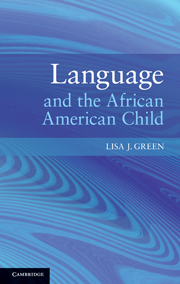Book contents
- Frontmatter
- Contents
- Figures
- Tables
- Foreword
- Preface
- Note on the text
- 1 Child AAE: an introductory overview of the data and context
- 2 Characterizing AAE: feature lists, dual components, and patterns and systems
- 3 System of tense–aspect marking 1: non-past and habitual
- 4 System of tense–aspect marking 2: past time
- 5 Negation: focus on negative concord
- 6 Asking questions: seeking clarification and requesting elaboration
- 7 Variation: intra-dialectal/variable-shifting and inter-dialectal/code-shifting
- 8 The D.I.R.E.C.T. Model: linking linguistic description and education
- Appendix A: List of participants
- Appendix B
- Notes
- References
- Index
5 - Negation: focus on negative concord
Published online by Cambridge University Press: 05 June 2012
- Frontmatter
- Contents
- Figures
- Tables
- Foreword
- Preface
- Note on the text
- 1 Child AAE: an introductory overview of the data and context
- 2 Characterizing AAE: feature lists, dual components, and patterns and systems
- 3 System of tense–aspect marking 1: non-past and habitual
- 4 System of tense–aspect marking 2: past time
- 5 Negation: focus on negative concord
- 6 Asking questions: seeking clarification and requesting elaboration
- 7 Variation: intra-dialectal/variable-shifting and inter-dialectal/code-shifting
- 8 The D.I.R.E.C.T. Model: linking linguistic description and education
- Appendix A: List of participants
- Appendix B
- Notes
- References
- Index
Summary
Dawn: I don’t wanna be no doctor. I wanna be a mailman.
Introduction
This chapter considers negation marking in child AAE, with a focus on negative concord. One general pattern that AAE shares with some languages, such as Romance and Slavic languages, as well as other non-standard varieties of English, is the use of multiple negative elements within a clause to convey a single negative meaning. For instance, in the sentence They didn’t have no books, negation is indicated on the auxiliary didn’t as well as within the noun phrase no books; however, the meaning of the sentence is the same as that of the corresponding single negation sentence with the negated auxiliary and polarity item any: They didn’t have any books. Thus the term for this type of multiple negation is generally known as negative concord given that the multiple negative elements are in agreement or concord with each other rather than each indicating separate negative meaning or each contributing further negative import to the sentence. Simply put, agreement or concord refers to the choice of a following negative element based on the preceding one. For instance, instead of no in They didn’t have no books canceling out the negative didn’t, resulting in the positive sentence They did have books, no occurs because there is a preceding negative (didn’t), not to add any negative meaning but to agree with the negative that is already present. Because multiple negative elements are used without changing the negative meaning of the sentence, negative concord has often been associated with emphatic interpretation, which would mean that the sentence in (1) is more emphatic than the one in (2):
Bruce didn’t have no book.
Bruce didn’t have a book.
While the sentence in (1) can certainly be emphatic, it is not necessarily so, and (2) can be as emphatic as (1), especially with emphasis on a book. Although negative concord is a stigmatized pattern, it does not present the type of interpretation challenges for speakers who do not understand AAE patterns that constructions such as aspectual be sequences present. That is, American English speakers who do not speak varieties of English in which negative concord is acceptable generally do not have problems understanding it. Charles Yang (2006, p. 120) goes even farther and notes the following: “Third, it is possible that everyone in America spoke a fragment of African American English at one point. Many children learning English, regardless of demographics, make frequent use of double or multiple negatives:
Daddy’s not being nothing.
I don’t want no milk!
He didn’t do nothing.
- Type
- Chapter
- Information
- Language and the African American Child , pp. 118 - 140Publisher: Cambridge University PressPrint publication year: 2010



